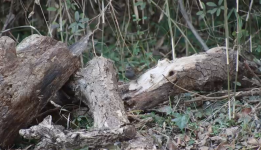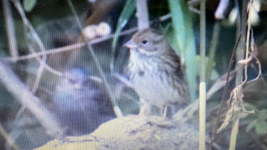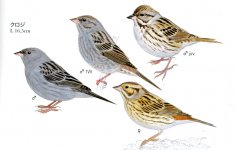-
Welcome to BirdForum, the internet's largest birding community with thousands of members from all over the world. The forums are dedicated to wild birds, birding, binoculars and equipment and all that goes with it.
Please register for an account to take part in the discussions in the forum, post your pictures in the gallery and more.
You are using an out of date browser. It may not display this or other websites correctly.
You should upgrade or use an alternative browser.
You should upgrade or use an alternative browser.
Buntings - Tokyo (1 Viewer)
- Thread starter Paul Collins
- Start date
More options
Who Replied?Joseph Bouvier
"No, that was a pigeon, not an eagle".

I'd say that the first one is a grey bunting and the second a reed bunting, but can't be sure because I have no experience with either.
Joseph Bouvier
"No, that was a pigeon, not an eagle".

Also if the second photo is of a reed bunting it would be a female.
When were they taken Paul? First i'd say is a Grey indeed, nice find (for him).... i wish i had found one.
2nd is tougher....I am struggling with that group of species that may look similar: Reed, Japanese Reed, Pallas's Reed, Black-faced, Little...I have some Japanese buntings to ID (march 2020)... so i am familiar with the difficulties...not with the ID.
the bicoloured bill looks odd but it looks most like a Little Bunting to me.
my 2p
cheers,
Gerben
2nd is tougher....I am struggling with that group of species that may look similar: Reed, Japanese Reed, Pallas's Reed, Black-faced, Little...I have some Japanese buntings to ID (march 2020)... so i am familiar with the difficulties...not with the ID.
the bicoloured bill looks odd but it looks most like a Little Bunting to me.
my 2p
cheers,
Gerben
Last edited:

I'd suggest Chestnut-eared Bunting for the second. It looks a bit heavy billed for Little and doesn't seem strongly marked enough on the head. It's also much more likely in Tokyo.
Paul Collins
Well-known member
Chestnut-Eared sounds possible, why not Black-Faced?
Not sure about exact part of Tokyo - but I think near a river if that is any help. Bull-headed shrike were seen there too, which as far as I know are more likely further out of the city than in the centre.
Not sure about exact part of Tokyo - but I think near a river if that is any help. Bull-headed shrike were seen there too, which as far as I know are more likely further out of the city than in the centre.
Alexander Stöhr
Well-known member
Normally I dont write on such a thread, but I cant resist: the second bird is not a Reed Bunting (at least of the eropean ssp). Head pattern is out of variation for this species, with such a broad supercilium, pale flesh lower mandible and what appears to be a solid median crown stripe. Minor differences are surely within variation, but together they produce an ood head pattern for a european Reed Bunting.
I hope this helpfull, its one of those threads I lean from!
I hope this helpfull, its one of those threads I lean from!
I'm an advanced beginner when it comes to bunting ID's but i'm learning and hope to learn more here.
@Paul Bull-headed Shrike can be found in most Tokyo parks and riverbanks, I guess, especially in winter.
I suppose these photos were taken recently?
@Alexander Japanese ssp of Reed Bunting does look different from the European ssp but the culmen appears straight, that should rule out Reed Bunting (if i am not mistaken)
@Andrew: I'll retract my ID, the headpattern is wrong for Little B.
cheers,
Gerben
@Paul Bull-headed Shrike can be found in most Tokyo parks and riverbanks, I guess, especially in winter.
I suppose these photos were taken recently?
@Alexander Japanese ssp of Reed Bunting does look different from the European ssp but the culmen appears straight, that should rule out Reed Bunting (if i am not mistaken)
@Andrew: I'll retract my ID, the headpattern is wrong for Little B.
cheers,
Gerben
Last edited:
Deb Burhinus
Used to be well known! 😎

That’s what I was thinking!Why isn't the second just a female/2cy Grey Bunting? The face pattern with contrastingly pale malar stripe and the dark tipped lower mandible look OK IMO.
That was the last thought i had, checked and dismissed some 30mins ago as I thought Grey should be more streaked and longer billed. But then the breast-streaks and billshape seem ok too when compared to Yann Muzika's Grey Bunting here: https://macaulaylibrary.org/asset/2...2.1641266049.1612090380-1354648253.1608070097
In the background is the male Grey Bunting again... so they were close together....most likely
In the background is the male Grey Bunting again... so they were close together....most likely
Last edited:
Deb Burhinus
Used to be well known! 😎

You can quite often judge a lady by the company she keeps 😉In the background is the male Grey Bunting again... so they were close together....most likely
Paul Collins
Well-known member
Thank you all, I keep learning new things here. The two birds were together. I’d seen illustration and photos of female grey bunting which didn’t quite match but this illustration seems a much better fit.If it was in the same place, and the season is right, then the second photo would fit juvenile male Grey Bunting. I hope uploading this is 'fair use'. This is from a recent Japanese guide.
View attachment 1369019
I agree I don’t see reed bunting here, but unsure of asiatic variations and if they’d differ.
Paul Collins
Well-known member
Interesting about the shrikes. Ive only visited Tokyo once but what I’ve seen in a few bird guides and eBird is of bull-headed shrikes being less common in the centre.I'm an advanced beginner when it comes to bunting ID's but i'm learning and hope to learn more here.
@Paul Bull-headed Shrike can be found in most Tokyo parks and riverbanks, I guess, especially in winter.
I suppose these photos were taken recently?
@Alexander Japanese ssp of Reed Bunting does look different from the European ssp but the culmen appears straight, that should rule out Reed Bunting (if i am not mistaken)
@Andrew: I'll retract my ID, the headpattern is wrong for Little B.
cheers,
Gerben
Deb Burhinus
Used to be well known! 😎

I’m not sure why you would exclude a juv female on the basis of your bird guide? Doesn’t a juvenile female look basically the same as a juv male!? Anyway, surely a 2cy rather than juvenile - Opus notes the breeding season for Grey Bunting is June/July which would make this a first winter/2cy would it not? In which case it would have to be 2cy female (or adult female) because a 1w/2cy male looks like thissecond photo would fit juvenile male Grey Bunting.

Grey Bunting - BirdForum Opus
So I agree with Roland.
Last edited:
I don t think they are common as in
I am glad the mystery seems to have been solved but it does add another option to the wide mix of reed bunting-ish buntings in japan,
cheers
Gerben
you'll see them anywhere like Brown-eared Bulbul and Long-billed Crow but I think that in winter and migration season they can pop up in near any park, river bank or temple complex as long as there is some suitable habitat. I have seen them at Kasai Rinkai Park and Sanbanze next the bay, Showa Kinen Park and Sumida and Tama river banks and there are records at inaturalist or observado.org from Yoyogi Park and the Imperial Palace Gardens.I am glad the mystery seems to have been solved but it does add another option to the wide mix of reed bunting-ish buntings in japan,
cheers
Gerben
Last edited:
Deb Burhinus
Used to be well known! 😎

We are all learning Paul, it’s a continual process.Thank you all, I keep learning new things here.
👍
Users who are viewing this thread
Total: 2 (members: 0, guests: 2)







